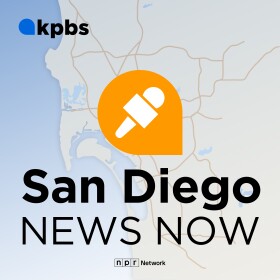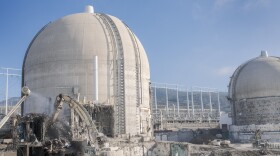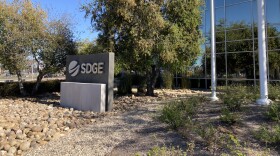Chuck Marohn is president of the nonprofit Strong Towns and author of the new book "Confessions of a Recovering Engineer," in which he picks apart everything that he sees wrong with his profession. Too often, he says, streets are designed to accommodate as many cars as possible at the fastest speed possible. Pedestrian and bike safety are often an afterthought.
KPBS spoke with Marohn ahead of his planned talk on Thursday at the San Diego History Center in Balboa Park.
RELATED: San Diego pledged to shift away from cars. So why is it still widening roads?
Q: So you chose to title your book "Confessions of a Recovering Engineer." What are you recovering from?
Man, I'm recovering from a decade or more of indoctrination. When you become a civil engineer, when you become a municipal engineer and you start doing things like traffic and sewer and water and all that stuff, there's a certain approach that is given to you, that you inherit. You're given a book of standards, you're given the best practices of a profession, and you have this expectation to follow that, particularly if you want to get ahead. And so for me, there was a certain kind of mystique that came with joining this profession, and learning those things and adopting them as “the way things should be” that I had to unlearn, that I really had to go through and get out of my brain.
RELATED: Five years into 'Vision Zero,' San Diego streets are even deadlier
Q: Throughout your book, you keep returning to this one particularly horrific crash that happened on Dec. 3, 2014 in Springfield, Massachusetts. Tell us what happened there.
A mom with two little girls was leaving the library in Springfield, Massachusetts late at night. They crossed the street headed to the parking lot, which is directly across this four-lane highway that's been built through the middle of the city. They did this in kind of the most natural of ways. And a car came along, struck them, put one girl in the hospital and then killed 7-year-old Destiny Gonzales. This has happened many times at this location. And in fact — we're speaking today on Nov. 12, 2021 — on Nov. 11, yesterday, one of the employees of the library walked out of the library, was walking across the street in this exact same location to get in her car, and she was struck and killed in this same spot.
And so this is a crossing that has a long history of taking lives, and a long history of mismatch between the design of the street and the goals and objectives of the engineer, in this case, and the health and safety of the community.
Q: A lot of these aspects that make a street very unsafe or inhospitable for pedestrians, I learned from your book, are actually designed to be safe — at least from the perspective of an old school traffic engineer. So describe for me what a safe street looks like from that perspective, and what do you see wrong with that picture?
When you're designing a highway, there's some very clear things that you do to make the highway safer for drivers. You widen out the lanes, you add in recovery areas, you add in clear zones, you basically create a lot of buffer so that the driver of the vehicle has a lot of room to react to things that might happen. You, from a design standpoint, forgive the mistakes that a driver would make by creating all this buffer.
When you bring that mindset into an urban area, what happens is that urban areas are full of complexity. They're full of automobiles that randomly stop or turn or cut across traffic. You have people walking, people walking across the street in crosswalks, not in crosswalks. You have people on bikes. You have people in wheelchairs. You have the dog that gets loose and runs across the street. You have the kid who chases the kickball. So you have all this complexity. Simultaneous to that complexity, what you have done with the street design is actually signaled to drivers: “We've got your back. We have provided you with lots of buffer room. You've got all kinds of safety factors.”
People would have to accept congestion as not a problem, but as actually a manifestation of the system that we built, a system that needs to change if you're going to meet those goals. And you would actually have to embrace congestion for what it is, which is a sign of demand for local alternatives.Chuck Marohn, author of "Confessions of a Recovering Engineer"
And the reality is that is the wrong message to send to drivers. Because what drivers do in an urban area, when you give them lots of room, is they speed up. And we're signaling the wrong things to drivers. We're signaling to drivers that this is a simple environment, like a highway, and so you don't have to pay really rigid, close attention. And most of the time, that's very true. But in these random occurrences where things are not where we expect them to be, tragedy occurs, and occurs far too often.
Q: What are the common themes that you find in cities that have made a lot of progress toward better street design and safer street design? What are the ingredients for success?
I see a lot of places that want to do things differently, and then they run up against the rules and regulations. And the ones that are very dogmatic about what the rules and regulations are, they get stuck at that point. They struggle. They're like, “Well, we can't do this because…” The ones that thrive are the ones not that say, “Well throw out the rule book and be careless and who really cares?” They are like, “Okay, here's an obstacle we've run up against. How do we get around this obstacle? How do we find a local adaptation to this?” And a lot of times that involves changing staff. A lot of times that involves creating a different channel for where this workflow would go. But a lot of times, it just requires us to sit down and collaborate.
RELATED: For grieving families, bike lane improvements come too late
Q: San Diego has set some very ambitious goals with cutting back on driving. It's adopted a Vision Zero goal to end all traffic deaths and serious injuries by 2025. It is in the process of updating its Climate Action Plan, which calls for half of all trips in the city to be made via biking, walking or public transit by 2035. But I don't think city leaders have a very clear picture of how they're going to get there exactly, how they'll accomplish that. What do you think would have to change? And how would our streets and our neighborhoods look differently if that is the goal?
People would have to accept congestion as not a problem, but as actually a manifestation of the system that we built, a system that needs to change if you're going to meet those goals. And you would actually have to embrace congestion for what it is, which is a sign of demand for local alternatives. And by local alternatives, that kind of gets to the second part. In order to reach these goals, which I think are very good goals, very worthy goals, what you need to have is not a transportation approach. You need to have a neighborhood development approach. Because to get to that goal, it requires people to have alternatives near them that they can walk to, alternatives near them that they can bike to.
The only way you get to that goal is to actually build neighborhoods — neighborhoods where people can replace their longer distance trips with local trips. So, I need milk. I need bread. I need to get my hair cut. I need to do whatever basic thing I do on a typical day — there has to be an alternative for that locally.








